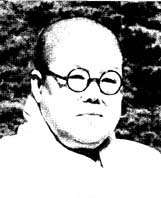Kim Iryeop
Kim Il-yeop or Kim Iryŏp, (hanja: 金一葉; 28 April 1896 - 28 May 1971) was a Korean writer, journalist, feminist activist, and Buddhist nun. Her given name was Kim Wonju (hanja: 金元周). Her courtesy and dharma name was Iryeop (Korean: hanja; Hanja: 一葉).[1]
Kim Iryeop | |
|---|---|
 Kim Iryeop c. 1935 | |
| Born | 28 April 1896 Yonggang, Korean Empire |
| Died | 1 February 1971 (aged 74) Sudeoksa, South Korea |
| Occupation | Poet, journalist, writer, painter, feminist activist, bhikṣuṇī |
| Nationality | Korean Empire, South Korea |
| Period | 1896-1971 |
| Genre | Buddhist philosophy, women's rights, New Women (신여성), poetry, novel, essay, drama |
| Spouse | Yi Noik (1919 - 1921, divorced) Ha Yunshil (1929 - 1930, divorced) |
Life
Kim Iryeop was born to a Methodist pastor and his wife in a northern part of the Korean Empire and grew to become an important modern literary, Buddhist and feminist thinker and activist.
Kim Iryŏp (1896-1971) was raised and initially educated in a devout Methodist Christian environment under the strict guidance of her fideistic pastor father and her mother who believed in female education. Both parents died while she was in her teens and she questioned her Christian faith at an early age. She was one of the first Korean women to pursue a higher education in Korea and Japan. Kim became a prolific poet and essayist, her writings engaging cultural and social issues, and a leading figure of the feminist “new woman” (sinyŏja) movement in the 1920s that promoted women’s self-awareness, freedom (including sexual freedom), and rights in the context of the complex intersection of traditional Korean Confucian society, Westernization and modernization, and Japanese colonial domination.
— Eric S. Nelson, "Kim Iryŏp’s Existential Buddhism"[2]
Having completed her primary education after the death of her parents, she moved to Seoul to attend Ehwa Hakdang (1913-1915) which is equivalent to high school education and in 1915 she moved on to Ehwa Hakdang (now Ewha Womans University). She completed her education at Ehwa in 1918 and married a professor of Yeonheui Junior College.
In 1919, Iryeop went to Japan to continue her studies and returned to Korea in 1920. Upon returning, she launched a journal, New Woman (Korean: 신여자; Hanja: 新女子), which is credited to be the first women's journal in Korea that was published by women for the promotion of women's issues.
Because of her great intelligence and unique literary talent, which manifested itself early in her life, Iryeop influenced the Korean literary society of her time. She wrote about activities that reflected trends in the women’s liberation movement and this impetus for her founding New Woman. Over the years, a great number of her critical essays, poems and short novels about women's liberation struggling against the oppressive traditions of the period of Korea under Japanese rule were published in such Korean-language daily newspapers as The Dong-a Ilbo and The Chosun Ilbo, as well as in literary magazines including Kaebyeok and Chosun Mundan (Korea Literary World).[1]
Iryeop ordained as a Buddhist nun in 1933 and moved into Sudeoksa in 1935, where she remained until she died.
Books
- Reflections of a Zen Buddhist Nun (어느 수도인의 회상, 1960)
- Having Burned Away My Youth (청춘을 불사르고, 1962)
- In Between Happiness and Misfortune (행복과 불행의 갈피에서)
English translation
Jin Y. Park, trans. Reflections of a Zen Buddhist Nun: Essays by Zen Master Kim Iryop (Honolulu, HI: University of Hawaii Press, 2014).
References
- Buddhist nun Iryŏp (Il-yeop)
- Nelson, Eric S. (July 2016). "Kim Iryŏp's Existential Buddhism". Philosophy East and West. 66 (3): 1049–1051. doi:10.1353/pew.2016.0070.
Sources
- Jin Y. Park, "Gendered Response to Modernity: Kim Iryeop and Buddhism." Korea Journal, Spring 2005.
- Jin Y. Park, "Women and Buddhist philosophy: Engaging Zen master Kim Iryŏp." Honolulu: University of Hawaiʻi Press, 2017.
External links
- Revisiting the women who changed Korea with their pens
- Buddhist nun Il-yeop - at The Korea Times
- 本映画のあらすじ(脚本・準備稿より) (in Japanese)
- 〈朝鮮近代史の中の苦闘する女性たち〉 女性雑誌編集者・金一葉 (in Japanese)
- Kim Il-yeop (in Korean)
- Kim Il-yeop:Navercast (in Korean)